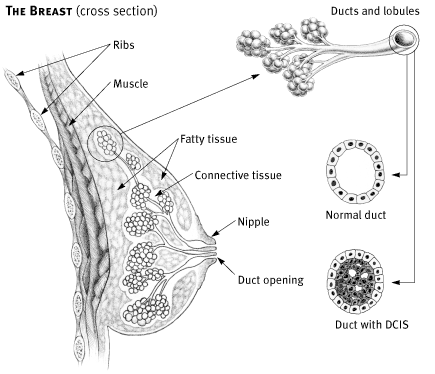This information is a general explanation only, and may not cover your situation exactly. All women with DCIS should obtain expert advice.
What is ductal carcinoma in situ?
Ductal carcinoma in situ (DCIS) is a condition that can occur in several different forms. In all of these, there's a change in the cells lining the milk ducts of the breast. Under a microscope, a normal duct shows a lining of a single layer of cells, but in DCIS, many more cells can be seen. Often the cells almost fill the duct, as illustrated below. For some women, DCIS is found in only a few ducts, but for others, it may be discovered in much of the duct system of the breast.
These extra cells in the duct show some of the abnormalities of cancer cells, but haven't spread outside the duct (in situ means 'in place'). For this reason, DCIS isn't considered to be 'true' or invasive cancer. When left untreated, DCIS may progress and invade nearby breast tissue, becoming a 'true' breast cancer. However, we cannot predict whether or when this will occur, so the condition needs to be treated. Treatment for DCIS should have a very good outcome because it should prevent progression to an invasive breast cancer.

Diagnosis and treatment of ductal carcinoma in situ
As screening mammography becomes more common, DCIS is diagnosed more often than in the past. More rarely, a woman may be diagnosed with DCIS after she finds a breast change such as a lump or a nipple discharge.
DCIS can often be seen as a particular pattern of tiny calcifications on the mammogram. Although the shape and size of the calcification may suggest DCIS to the radiologist, the diagnosis will need to be confirmed by further investigation. The doctor will usually recommend a core needle biopsy, which involves removal of a sliver of tissue through a needle under local anaesthetic. This tissue is then sent to a pathologist . The diagnosis may also be made by surgical (open) biopsy. A surgical biopsy is done in a hospital, but you usually won't have to stay overnight.
Treatment for DCIS depends on each woman's situation. More often than in the past, doctors are able to offer conservative treatment. This means the surgeon will only remove the area of DCIS, along with a small border of unaffected tissue. Occasionally, further treatment by radiation will be suggested. Radiation therapy can have side effects, and you should find out about these before starting a course of treatment. See our Radiotherapy page for more.
After this conservative surgery is completed, with or without radiation, there's some risk of recurrence. Sometimes the recurrence will be DCIS (still within the duct), but sometimes it will be invasive breast cancer (spreading into the tissue outside the duct). There's no evidence of any benefit from axillary dissection (removal of lymph nodes from the armpit) in women with DCIS 1.
For some women, the doctor will recommend a mastectomy (removal of the affected breast). No further treatment is needed for that breast following mastectomy, and the future risk of breast cancer becomes very small—around 1%. The other breast should be regularly checked by mammography and physical examination.
Follow-up
When you've been treated for DCIS, you'll probably be advised to have more frequent mammograms than before, and regular physical examination. Your doctor may also want to check that you're aware of the best way to examine your own breasts for signs of unusual change.
Tamoxifen therapy may be recommended after DCIS has been diagnosed and treated. It's taken in tablet form for up to 5 years. Tamoxifen has a proven role in the treatment of invasive breast cancer, and there are now clinical trials indicating it's useful in treating DCIS.
Hormone replacement therapy
Women with a diagnosis of DCIS may think about taking hormone replacement therapy (HRT) if they're troubled by symptoms arising from menopause. Although the risks are unclear, the benefits of HRT can be important for individual women. If you're considering taking HRT, discuss your situation with your doctor. In particular, ask about the appropriate dosage, the length of time to continue taking HRT, and any other preparations that may help with problems arising from menopause.
You can also ring the Cancer Council on 13 11 20 to discuss questions of concern to you.